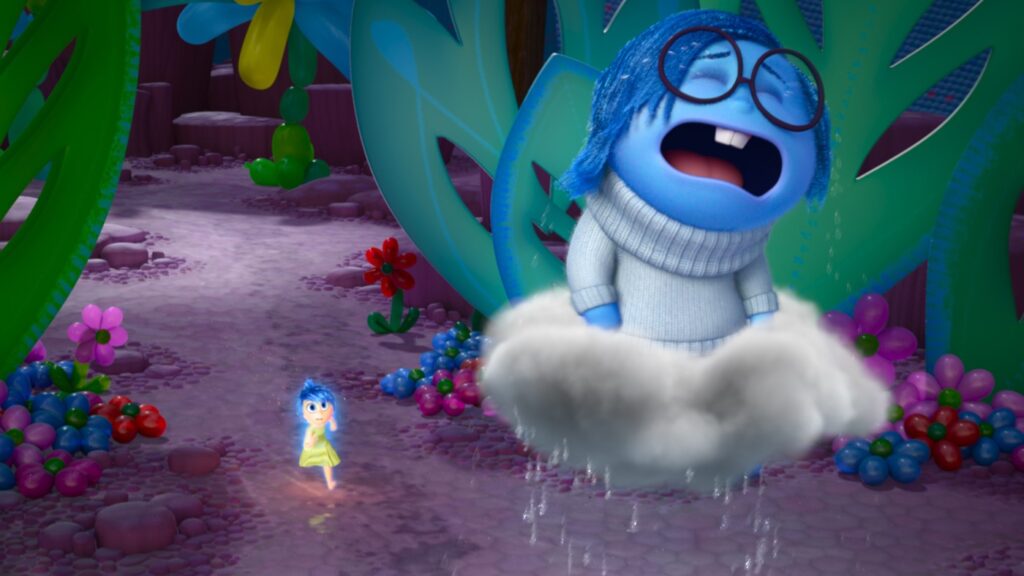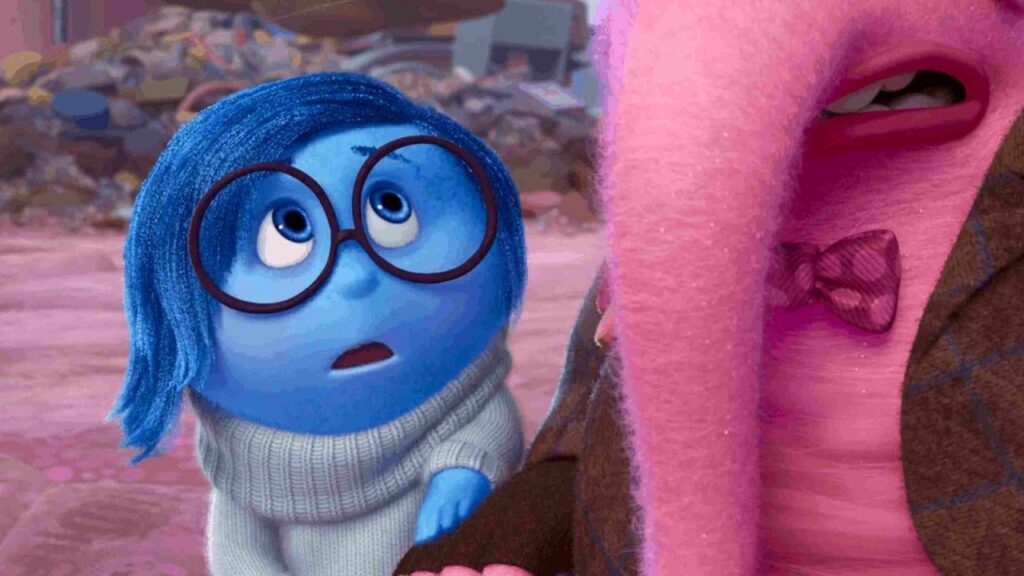This post includes a brief plot summary, an explanation about the ending of the film Inside Out (2015) and a discussion about the importance of sadness. Why is sadness important? Why do we need it? Beware of spoilers.

Directed by Pete Docter and Ronnie Del Carmen, the 2015 animated comedy stars Amy Poehler as Joy and Phyllis Smith as Sadness.
The World Of “Inside Out” Explained
Everything that we see in Inside Out is happening inside Riley’s head, a young girl from Minnesota.
The film introduces emotions as characters and they’re the ones influencing Riley’s decisions. Therefore, everything that happens in the Headquarters has a direct impact on Riley’s life.
THE HEADQUARTERS
The Headquarters are responsible for Riley’s emotions, they control how she feels. There are mainly five characters working at the Headquarters: Joy, Fear, Anger, Disgust and Sadness. Joy is the self-proclaimed leader of the group. Many of her duties include: controlling all the other emotions and keep things in order (to keep Riley happy).
MEMORY STORAGE AND MEMORY DUMP
New experiences eventually turn into new memories. Joy’s job is to pick these memories (shaped as coloured orbs) and send them to Riley’s long-term memory storage. The Memory Dump on the other hand, is the place where memories fade away and it’s located right under the personality islands.
CORE MEMORIES AND PERSONALITY ISLANDS
What are core memories? Riley’s life is composed of moments. “Core memories” are the most significant moments that helped Riley shape her personality. Different core memories “power” different aspects of her personality, called “personality islands”.
Inside Out (2015) – Plot Summary
Riley is a young girl from Minnesota and she is moving to San Francisco because of her father’s new job. However, not everything is running smoothly during this transition.
On Riley’s first day of school, Sadness touches some of her happy memories. As a result, Riley starts crying profusely. Out of sheer panic, Joy tries to isolate Sadness and get rid of the sad memory. However, Sadness wants to keep it. Therefore, the two scuffle and Joy inadvertently knocks some of the core memories loose, which causes the personality islands to shut down. Meanwhile, the memory tube sucks both Joy and Sadness out of the Headquarters and sends them to the long-term memory storage.
Without Joy at the Headquarters, all the others emotions are out of control. As a result, Riley starts distancing herself from her loved ones. Some of her personality islands eventually crumble and fall into the Memory Dump. Meanwhile, Anger inserts a new idea into the console: running away to Minnesota to be happy again.
At the long-term memory storage, Sadness and Joy meet Bing Bong, Riley’s old imaginary friend. Bing Bong suggests the Train of Thought to get Joy and Sadness back to the Headquarters. Everything goes well, until Riley falls asleep (the train stops). The three try to wake Riley up, by interrupting one of her dreams. The plan works for a while until the moment Riley steals her mother’s credit card. The Honesty Island crumbles and the Train of Thought derails.
A desperate Joy abandons Sadness and tries to ride a recall tube back to the Headquarters, but the ground below the tube collapses, propelling Joy and Bing Bong into the Memory Dump.
When Joy was about to lose hope, she takes a look at Riley’s memories and realizes that one her happiest memories actually came from a sad moment. Back in Minnesota, Riley missed a pivotal shot in a hockey game which cost her team the win. It’s was Sadness, that prompted Riley’s parents and friends to help her and cheer her up. This made Joy understand that Sadness is useful and necessary.
At the Memory Dump, Bing Bong and Joy try to escape using Bing Bong’s old wagon. However, the wagon is too small for the two of them. Therefore, Bing Bong decides to sacrifice himself in order to let Joy escape. Then, he fades away.
Joy reunites with Sadness and together they head back to the Headquarters. Anger’s idea left Riley apathetic. With Joy’s permission, Sadness steps in, takes over the console and unplugs Anger’s idea of going back to Minnesota. Riley starts feeling sad for leaving her parents and returns home.
When Riley returns home, she lets her parents know that she misses Minnesota. Riley’s parents comfort her and reassure her that they feel the same way. Meanwhile, Joy and Sadness manage the console together, as new memories and new personalities islands form.
A year later, Riley is more accepting of her new life in San Francisco. She has made new friends and returned to her old hobbies, while acquiring new ones. Things are a bit different at the Headquarters too, the emotions are all working together in a expanded console.
Inside Out (2015) – Sadness Ending Explained
It’s ironic to arrive at the end of the film and realize that Joy was actually the problem (not Sadness). So what was Joy doing wrong? While Joy’s intentions of keeping everyone around her happy are good, it’s not always the most appropriate thing to do.
When Joy was trying to keep Sadness isolated and away from Riley’s memories, Joy was actually preventing Riley from feeling happiness. If Riley cannot feel sadness, then she won’t be able to tell if something is wrong or not, let alone reach out to someone. When Joy and Sadness were absent from the Headquarters, Riley wasn’t really able to process her emotions in a normal manner. Even during her attempt to go back to Minnesota, Riley was pretty much emotionless. Then, when Sadness was in charge of the console, Riley was able to feel sad which led her to go back and reach out to her parents for comfort. Her parents understood what Riley was going through, which made her feel relieved and loved, hence, bringing her happy feelings again.
Why Is Sadness Important?

#1 – Empathy And Compassion. Sadness was the only one able to comfort Bing Bong (Riley’s imaginary friend) when he was feeling down. Joy is all about good vibrations, which is a good thing. However, that makes her completely clueless about what to do when someone is feeling sad.
#2 – Support. Sadness is not a pleasant emotion, but it can come in handy sometimes. When someone is sad for whatever reason, the body tends to send signals, which helps the people around us understand that we might need some help. When Riley “allowed” herself to be sad, her parents were finally able to understand her pain / frustration and provide her the support she needed.
#3 – Appreciation. Sadness and Joy are like yin-yang. They are very different. As a matter of fact, they are complete opposites. However, they need each other to co-exist and to create balance. In addition, memories are complex, composed of many emotions mixed together. Joy comes to that realization at the very end of the film. Different emotions can co-exist and that’s what makes memories special. For instance, Sadness makes Riley more appreciative of her happy memories.
The end of Inside Out shows that though sadness is an unpleasant emotion, it serves a purpose. That’s why Joy and Sadness start working together at the console.
Final Thoughts
Inside Out was one of the most educating and eye-opening experiences that I’ve had in a while. The film does an excellent job at explaining complex matters such as emotions in a simple way for kids and adults. On the surface, Inside Out looks like a feel-good film, something light and fun, but this little gem is so much more than that.
The film touches upon a sensitive subject which is our perception of sadness. Maybe in the beginning, many of us are more empathetic towards Joy, especially the first time we see Sadness touching Riley’s memories. The fear and frustration that Joy felt at that scene, it resonates a lot, especially with how many deal with unpleasant emotions.
Why is Sadness so unwanted? Joy tried to isolate Sadness and keep her away from everyone. However, how do others cope with sadness? Probably the same way Joy does. To be honest, there’s no manual that teaches people how to deal with Sadness. What do you do to things that you find unpleasant? You push them away. That’s what Joy did (and most of us would do), she didn’t want to deal with Sadness. Therefore, Joy decided to put her inside a circle.
Overall, Inside Out is a film with a lot of heart. It does a magnificent job at explaining emotions in a relatable way. In addition, it teaches the importance of embracing emotions and this applies to both kids and adults. Inside Out has shown us that we shouldn’t tag sadness as a bad emotion, instead we should treat our little “blue friend” with more patience and kindness. At the end of day, sadness is important too and we shouldn’t be treating it as a foreign object to which we are allergic to.


